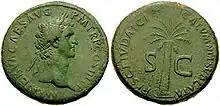Fiscus Judaicus
Der Fiscus Judaicus (lateinisch für Judensteuer) war eine Steuer, die den Juden nach der Zerstörung des Jerusalemer Tempels im Jahre 70 n. Chr. von Kaiser Vespasian auferlegt wurde. Die Steuer kam anfänglich dem Wiederaufbau des Tempels des Jupiter Optimus Maximus in Rom zugute, der durch einen Brand beschädigt worden war.[1]

Gemäß Sueton wurde der Fiscus Judaicus unter Kaiser Domitian besonders streng eingetrieben,[2][3] und er wurde auch von Judenchristen und Heidenchristen eingezogen,[4][5] denn die Römer betrachteten zu diesem Zeitpunkt sowohl Judenchristen als auch Heidenchristen als Ausprägungen des Judentums.[6][7]
Unter Kaiser Nerva wurden dann Münzen geprägt, die die Aufschrift FISCI IUDAICI CALUMNIA SUBLATA trugen.[1][2] Die Inschrift ist nicht eindeutig, es besteht aber Übereinstimmung, dass der Fiscus Judaicus in irgendeiner Form reformiert wurde.[1][2] Gemäß dieser Quelle gibt es mehrere Möglichkeiten der Übersetzung.[8] Laut dieser Quelle[9] wurde nur die Praxis der falschen Anschuldigung, dass jemand Anhänger des Judentums sei, zurückgenommen. Wie Cassius Dio berichtet, wurde z. B. Titus Flavius Clemens, der Cousin von Kaiser Domitian wegen dieser Anschuldigung hingerichtet.[10]
Der Fiscus Judaicus selbst wurde weiterhin erhoben,[1] mindestens bis in die Zeit des Origenes.[11] Es ist aber unklar, bis zu welchem Zeitpunkt genau der Fiscus Judaicus erhoben wurde. Möglicherweise wurde er erst unter Julian 362 n. Chr. abgeschafft.[12]
Gemäß dieser Quelle[13] führte die Reform des Fiscus Judaicus unter Nerva zu einer Trennung der Wege von Judentum und Christentum.[14] Vor der Reform von Nerva war den Römern das Christentum zwar suspekt, wurde aber als Teil des Judentums angesehen.[7] Seit dem Jahr 96 n. Chr. verwendete die römische Obrigkeit dann eine strengere Definition des Begriffs Jude, die es ihr erleichterte, zwischen dem Judentum (als religio licita, einer im Reich akzeptierten Religion) und dem Christentum (als superstitio illicita, einer illegalen religiösen Bewegung) zu unterscheiden.[15][16]
Einzelnachweise
- http://www.jewishencyclopedia.com/articles/6157-fiscus-judaicus
- http://www.biblicalarchaeology.org/reviews/the-fiscus-judaicus-and-the-parting-of-the-ways/
- Louis H. Feldman, Shaye J. D. Cohen, Joshua J. Schwartz; Studies in Josephus And the Varieties of Ancient Judaism, BRILL, 2007, S. 86 “that under Domitian iudaicus fiscus acerbissime actus est”
- http://www.biblicalarchaeology.org/reviews/the-fiscus-judaicus-and-the-parting-of-the-ways/ “[..] those who lived a Jewish life without publicly acknowledging the fact and those who concealed their Jewish origins. [..] Heemstra argues that the first category includes gentile Christians (who lived a Jewish life without publicly acknowledging the fact) and the second includes Jewish Christians (ethnic Jews who concealed their Jewish origins).”
- http://www.jewishencyclopedia.com/articles/6157-fiscus-judaicus “[..] those that lived a Jewish life without paying the tax, or that sought to keep their origin secret [..]”
- http://www.biblicalarchaeology.org/reviews/the-fiscus-judaicus-and-the-parting-of-the-ways/ “In other words, the Romans regarded both gentile Christianity and Jewish Christianity as forms of Judaism, hence liable to the tax.”
- Marius Heemstra: The Fiscus Judaicus and the Parting of the Ways, Mohr Siebeck, 2010, S. 202 “Christianity related to Judaism, but suspect”
- Louis H. Feldman, Shaye J. D. Cohen, Joshua J. Schwartz; Studies in Josephus And the Varieties of Ancient Judaism, BRILL, 2007, S. 85–87
- A. [A specific case in which] a false accusation was brought to the treasury for Jewish affairs has been struck out.
- B. [All bringing of] malicious accusation[s] to the treasury responsible for Jewish affairs has been brought to an end.
- C. A [specific case in which] a false accusation was brought by the treasury for Jewish affairs has been struck out.
- D. The false accusation [against all Jews made by] the treasury for Jewish affairs has been wiped away.
- E. Mary Smallwood: The Jews Under Roman Rule, BRILL, 2001, S. 378 “The coins commemorate the abolition [..] of calumnia, false charges [..] the coin-legend concentrates on groundless denunciations [..] and proclaims the end of the abuse [..]”
- E. Mary Smallwood: The Jews Under Roman Rule, BRILL, 2001, S. 378 “[..] the charge against them was atheism, a charge on which many others who were drifting into Jewish ways were condemned [..]”
- Martin Goodman: Nerva, the Fiscus Judaicus and Jewish Identity, The Journal of Roman Studies Vol. 79, (1989), S. 44 “[..] for its imposition was still in operation in the time of Origen [..]”
- http://www.fordham.edu/halsall/jewish/julian-jews.asp “In a famous Greek letter to the Jews, [..], he abolished the special taxes paid to the Roman government [..]”
- Marius Heemstra: The Fiscus Judaicus and the Parting of the Ways, Mohr Siebeck, 2010
- http://www.biblicalarchaeology.org/reviews/the-fiscus-judaicus-and-the-parting-of-the-ways/ “In sum, the social, political and cultural separation between Jews and Christians, usually called the ‘parting of the ways’, was substantially complete by 100 C.E., and set in place first and foremost by Nerva in 96 C.E. as part of his reform of the fiscus Judaicus.”
- http://www.mohr.de/de/judaistik/fachgebiete/antike/buch/the-fiscus-judaicus-and-the-parting-of-the-ways.html@1@2Vorlage:Toter+Link/www.mohr.de (Seite+nicht+mehr+abrufbar,+Suche+in+Webarchiven) Datei:Pictogram+voting+info.svg Info:+Der+Link+wurde+automatisch+als+defekt+markiert.+Bitte+prüfe+den+Link+gemäß+Anleitung+und+entferne+dann+diesen+Hinweis.+
- Marius Heemstra: The Fiscus Judaicus and the Parting of the Ways, Mohr Siebeck, 2010, S. 201–203